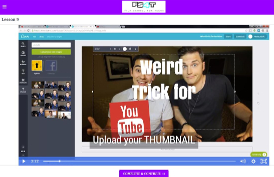The YouTube for Teens Video Course teaches teens how to create YouTube content then monetize their work by building a channel and creating a following. The approach gives students an opportunity to be both creative and entrepreneurial.
This online course is presented in 12 sections, and each section has two video segments and an assignment. There’s also a 50-page PDF manual with blanks for students to fill in as they watch the videos. This results in notes that summarize the key points of each lesson.
Students will actually create a YouTube series with at least 25 videos. At the beginning of the course, they work on coming up with an idea that has a potential audience and that the students will enjoy working on consistently to keep coming up with new content.
The course's teacher and host, Damon Evans, interviews experts in the field to present some useful strategies. He also interviews young people who are working through the same process as those who are watching the videos. For instance, two young men want to do their YouTube videos on Funko Pops™, so Evans asks them questions that help them figure out how they might come up with 25 videos. This process helps students taking the course think through whether or not their subject is broad enough or interesting enough for them to create enough content before they get started.
The lessons discuss different aspects of the process, such as selecting a camera to use, editing video footage, shooting the first video, creating a YouTube channel, optimizing videos, creating revenue streams, and marketing the YouTube channel. Some of these sections direct students to YouTube tutorials for specific instructions that fit individual situations. For example, the choice of editing software will depend upon the student’s device, so they will need to choose the tutorial for their computer or device. Students will invest time researching and watching other videos in addition to those provided with the course. The lesson notes sometimes suggest videos or websites where students can find what they need, but they will also have to do some of their own research.
The videos for this course are high-quality, professional presentations as one would expect from someone who is teaching others how to make videos. The first video segment for each lesson tends to be lively and fast paced, with content that is both useful and well presented. Students can also learn a great deal by simply analyzing the video lessons themselves aside from the content. So it's probably worth having students watch these lively segments a second time to observe Evans’ presentation style, the variety of approaches he uses to convey information, and his film-making techniques.
The second video segment (included for all except the first and final lessons) is labeled “Deep Thoughts.” In most of these segments, Evans interviews his friend Jason, delving into philosophical and spiritual questions, such as the meaning of success from a Christian perspective. In two Deep Thoughts, Evans interviews another friend, Andrea, and they discuss motivational questions as well as some practical issues. All of the Christian content is in this second video segment of each lesson. While the version of the course I reviewed was for Christian students, there is a version of this course that is not faith based and can be used by charter school students. See the publisher's website.
As with Evans' other course that I reviewed, Intro to Filmmaking, this one is great for homeschooling teens—and maybe even some pre-teens. The course requires real work, but students will learn valuable skills that might even help them to earn some money in the near future.








